Related Research Articles

Thai cuisine is the national cuisine of Thailand.

A pancake is a flat cake, often thin and round, prepared from a starch-based batter that may contain eggs, milk and butter and cooked on a hot surface such as a griddle or frying pan, often frying with oil or butter. Archaeological evidence suggests that pancakes were probably the earliest and most widespread cereal food eaten in prehistoric societies.

Appam is a South Indian pancake dish, made with fermented rice batter and coconut milk, common in the South Indian states of Karnataka, Tamil Nadu and Kerala, as well as in Sri Lanka. It can be made and served in both sweet and savoury varieties, with the centre of the appam having either a creamy, coconut milk layer or a sunnyside up-style fried egg. Appam is usually served for breakfast or dinner.

Khanom Buang, known as Thai crepes in English. Kanom Bueang is an ancient Thai dessert known as crispy pancakes in English. It is a popular form of street food in Thailand. These crepes look a bit like tacos. Khanom bueang are usually first topped or filled with meringue, followed by sweet or salty toppings such as shredded coconut, Foi Thong, or chopped scallions.

Serabi, also called surabi, srabi, also known in Thailand as khanom khrok, is an Indonesian pancake that is made from rice flour with coconut milk or shredded coconut as an emulsifier. Most of traditional serabi tastes sweet, as the pancake is usually eaten with kinca or thick golden-brownish-colored coconut sugar syrup. However, another savoury version also existed that uses oncom toppings. Different provinces in various Asian countries have their own serabi recipes corresponding to local tastes.
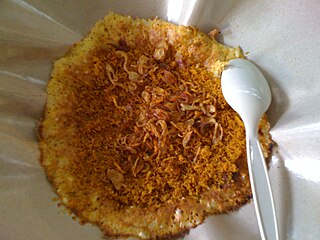
Kerak telor is a Betawi traditional spicy omelette dish in Indonesian cuisine. It is made from glutinous rice cooked with egg and served with serundeng, fried shallots and dried shrimp as topping. It is considered as a snack and not as a main dish. The vendors of kerak telor are easily the most ubiquitous during annual Jakarta Fair and it has also become a must-have menu item for visitors at the event.

Street food, as in other areas of India, are popular in Chennai, despite the common belief in India that street food is unhealthy. The Idly Sambhar is a popular dish, which is served as breakfast or dinner. Apart from regular South Indian street food, the city's streets are also filled with several North Indian street food outlets, most of them established by North Indian migrants themselves. Gujarati and Burmese are also available. Street food in Chennai is so popular that a game had developed based on the TV show The Amazing Race where contestants have to follow clues to Street-food spots in the city.

Kue cucur (Indonesian) or kuih cucur (Malay), known in Thai as khanom fak bua or khanom chuchun, is a traditional snack from Indonesia, and popular in parts of Southeast Asia, includes Indonesia, Malaysia, southern Thailand and Vietnam. In Indonesia, kue cucur can be found throughout traditional marketplaces in the country; the popular version, however, is the Betawi version from Jakarta. In Brunei and Malaysia, the term cucur is generally used to refer to any type of fritters. A popular type of cucur in Brunei and Malaysia is Jemput-jemput and Pinjaram. In Southern Thailand, it is often featured in wedding ceremonies and festivals.
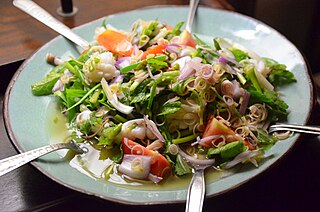
Salads that are internationally known as Thai salads, with a few exceptions, fall into four main methods of preparation. In Thai cuisine these are called yam, tam, lap and phla. A few additional dishes can also be regarded as being a salad.
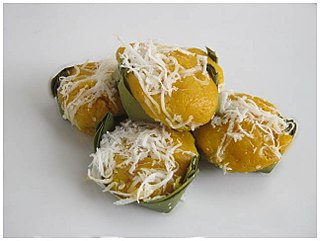
Khanom tan is a local popular Thai dessert which can be found in the provinces that have sugar palm, such as Phetchaburi, Nakhon Pathom and Suphanburi.

A deep fried Oreo is a dessert or snack consisting of an Oreo which is dipped in batter and deep-fried. It can be served with different toppings or simply with no toppings. Deep fried Oreos are generally made using the Oreo cookies by the Nabisco division of Mondelēz International, but also can be made of other chocolate sandwich cookies.

Street food in Thailand brings together various offerings of ready-to-eat meals, snacks, fruits and drinks sold by hawkers or vendors at food stalls or food carts on the street side in Thailand. Sampling Thai street food is a popular activity for visitors, as it offers a taste of Thai cooking traditions. Bangkok is often mentioned as one of the best places for street food. In 2012, VirtualTourist named Bangkok as the number one spot for street food—the city is notable for both its variety of offerings and the abundance of street hawkers.
Chak Phra is a Buddhist festival that is celebrated annually in Southern Thailand. The named could be translated as “Pulling the Buddha”, “pulling of the Buddhist monks”, or “pulling of ceremonial Buddha image carriages”.
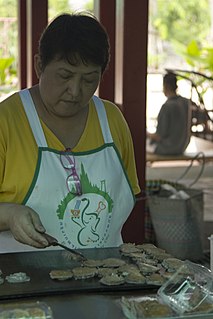
Khanom babin, also spelled as kanom babin, is a popular Thai dessert that comes from Ayutthaya. It is made from young coconut, rice flour, coconut milk, sugar and egg. Nowadays, Khanom Babin is not well-known among younger generations because it is rarely found in local streets or markets.
Khanom thian is a type of Thai khanom prepared in the shape of a candle. It originated in northern Thailand, and is used by some people as a ceremonial dish.

Cassava cake is a traditional Filipino moist cake made from grated cassava, coconut milk, and condensed milk with a custard layer on top. It is a very popular dish in the Philippines, where it is commonly eaten for merienda. It is also served during gatherings and special occasions.
Khanom sai bua is a type of Thai dessert. It is regarded as another type of traditional Thai dessert that is hard to find and few people know.
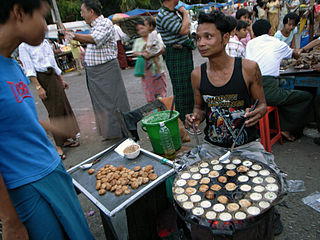
Mont lin maya is a traditional Burmese street snack or mont. The Burmese name literally means "husband and wife snack", and is also known as mont ok galay or mont maung hnan in Mawlamyine and Upper Myanmar.

Sanwin makin is a traditional Burmese dessert or mont, popularly served during traditional donation feasts, satuditha feasts, and as a street snack. The dessert bears resemblance to desserts in neighboring India, where it is called sooji halwa, and Thailand, where it is called khanom mo kaeng.
References
- ↑ "Poorman's Pancake" . Retrieved 30 November 2005.
- ↑ ImportFood. "Tang Taek (Bankruptcy Sweets) :: ImportFood". importfood.com.
- ↑ "Thai street food: khanom tang taek". 7 March 2016.
- ↑ "Poorman's Pancake | Thai Desserts | Thai language school TLS bangkok". www.studybangkok.org.
- ↑ "Poorman's Pancake". enjoythaifood. Retrieved 30 November 2005.
| This dessert-related article is a stub. You can help Wikipedia by expanding it. |